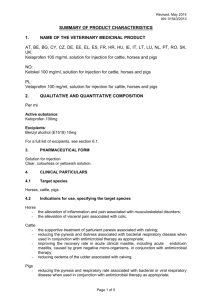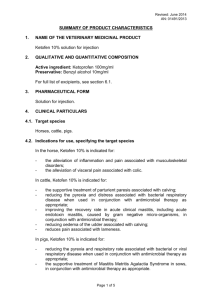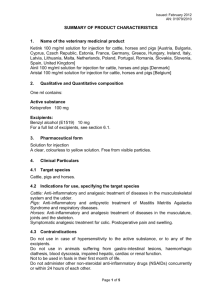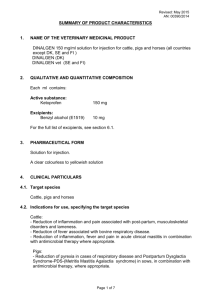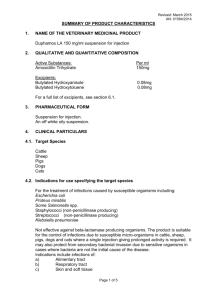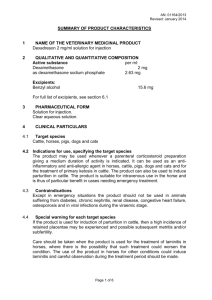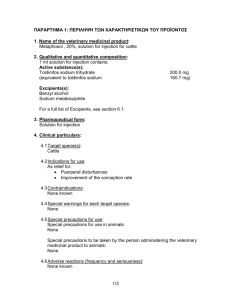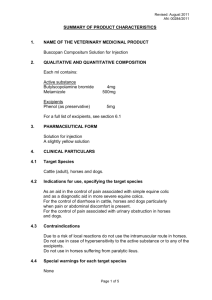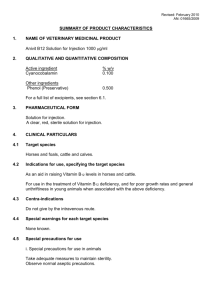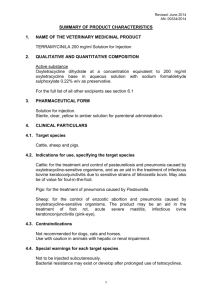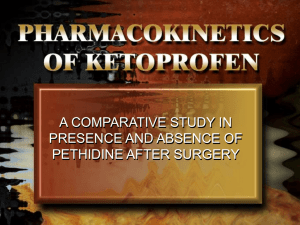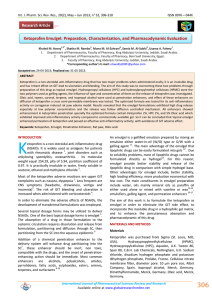Issued: October 2012 AN: 00043/2011 SUMMARY OF PRODUCT
advertisement
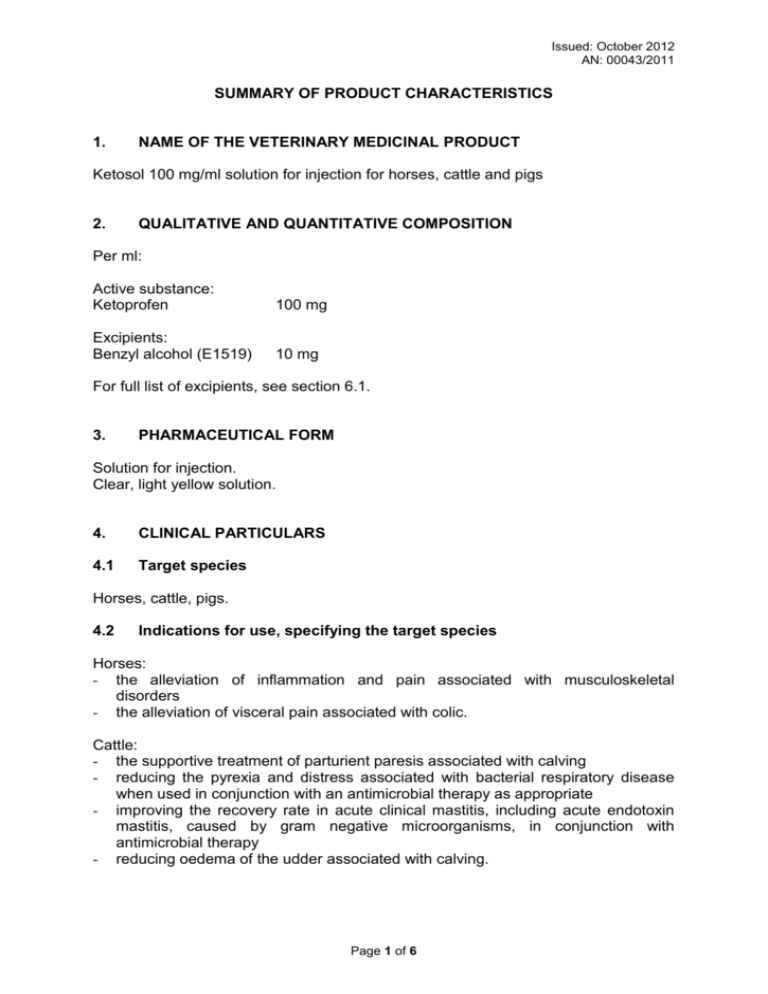
Issued: October 2012 AN: 00043/2011 SUMMARY OF PRODUCT CHARACTERISTICS 1. NAME OF THE VETERINARY MEDICINAL PRODUCT Ketosol 100 mg/ml solution for injection for horses, cattle and pigs 2. QUALITATIVE AND QUANTITATIVE COMPOSITION Per ml: Active substance: Ketoprofen 100 mg Excipients: Benzyl alcohol (E1519) 10 mg For full list of excipients, see section 6.1. 3. PHARMACEUTICAL FORM Solution for injection. Clear, light yellow solution. 4. CLINICAL PARTICULARS 4.1 Target species Horses, cattle, pigs. 4.2 Indications for use, specifying the target species Horses: - the alleviation of inflammation and pain associated with musculoskeletal disorders - the alleviation of visceral pain associated with colic. Cattle: - the supportive treatment of parturient paresis associated with calving - reducing the pyrexia and distress associated with bacterial respiratory disease when used in conjunction with an antimicrobial therapy as appropriate - improving the recovery rate in acute clinical mastitis, including acute endotoxin mastitis, caused by gram negative microorganisms, in conjunction with antimicrobial therapy - reducing oedema of the udder associated with calving. Page 1 of 6 Issued: October 2012 AN: 00043/2011 Pigs: - reducing the pyrexia and respiratory rate associated with bacterial or viral respiratory disease when used in conjunction with antimicrobial therapy as appropriate - the supportive treatment of Mastitis Metritis Agalactia Syndrome in sows, in conjunction with antimicrobial therapy as appropriate. 4.3 Contraindications Do not use in horses, cattle or pigs that have previously shown a hypersensitivity to ketoprofen. Do not administer other non-steroidal anti-inflammatory drugs (NSAIDs) concurrently or within 24 hours of each other. Do not use in animals suffering from cardiac, hepatic or renal disease, where there is the possibility of gastrointestinal ulceration or bleeding, where there is evidence of a blood dyscrasia or hypersensitivity to the medicinal product. 4.4 Special warnings for each target species None 4.5 Special precautions for use Special precautions for use in animals Use in any animal less than 6 weeks of age or in aged animals may involve additional risk. If such use cannot be avoided animals may require a reduced dosage and careful management. Do not use in foals under the age of 15 days. Avoid use in any dehydrated, hypovolemic or hypotensive animals as there is a potential risk of increased renal toxicity. Avoid intra-arterial injection. Do not exceed the stated dose or duration of treatment. Special precautions to be taken by the person administering the veterinary medicinal product to the animals In case of accidental self-injection seek medical advice and show the package leaflet or the label to the physician. People with known hypersensitivity to the active substance and/or benzyl alcohol should avoid contact with the product. Avoid splashes on the skin and eyes. Wash the affected area thoroughly with water should this occur. If irritation persists seek medical advice. Wash hands after use. Page 2 of 6 Issued: October 2012 AN: 00043/2011 4.6 Adverse reactions (frequency and seriousness) In common with all NSAIDs, due to their action of inhibition of prostaglandin synthesis, there can be a possibility in certain individuals of gastric or renal intolerance. Allergic reactions may occur very rarely, in this case the treatment should be stopped. Following intramuscular injection, local irritation at the injection site can be seen. 4.7 Use during pregnancy, lactation or lay The safety of ketoprofen has been investigated in pregnant animals (rats, rabbits) and cattle. Ketoprofen showed no teratogenic or embryotoxic effects. However, in the absence of specific data in pregnant mares and sows, the use of the product in these animals should be subject to a benefit/risk assessment by the responsible veterinarian. It is indicated for use in lactating sows. 4.8 Interaction with other medicinal products and other forms of interaction Some NSAIDs may be highly bound to plasma proteins and compete with other highly bound drugs which can lead to toxic effects. Concurrent administration with nephrotoxic drugs should be avoided. Concurrent administration of other steroidal or non-steroidal anti-inflammatory drugs, diuretics or anticoagulant agents may lead to potentiating adverse effects. A treatment free period, dependent on the product administered, should be observed between such treatments. 4.9 Amounts to be administered and administration route Horse: intravenous use For use in musculoskeletal conditions, the recommended dosage is 2.2 mg ketoprofen /kg of body weight, i.e. 1 ml of the product /45 kg of body weight, administered by intravenous injection once daily for up to 3 to 5 days. For use in equine colic, the recommended dosage is 2.2 mg ketoprofen /kg of body weight, i.e. 1 ml of the product /45 kg of body weight, given by intravenous injection for immediate effect. Only after a thorough re-examination a second injection may be given if colic recurs. Cattle: intravenous use, intramuscular use The recommended dosage is 3 mg ketoprofen /kg of body weight, i.e. 1 ml of the product /33 kg of body weight, administered by intravenous or deep intramuscular injection once daily for up to 3 days. Pig: intramuscular use The recommended dosage is 3 mg ketoprofen /kg of body weight, i.e. 1 ml of the product /33 kg of body weight, administered once by deep intramuscular injection. Do not administer more than 10 ml at each injection site. The stopper cannot be punctured more than 20 times. Page 3 of 6 Issued: October 2012 AN: 00043/2011 4.10 Overdose (symptoms, emergency procedures, antidotes), if necessary No clinical signs were observed when ketoprofen was administered to horses at 5 times the recommended dose for 15 days, to cattle at 5 times the recommended dose for 5 days, or to pigs at 3 times the recommended dose for 3 days. 4.11 Withdrawal period(s) Horses, cattle and pigs must not be slaughtered for human consumption during treatment. Animals may be slaughtered for human consumption only after the following periods from the last treatment: Cattle meat and offal: following intravenous administration - 1 day following intramuscular administration - 4 days milk: zero hours Pigs (meat and offal): 4 days Horses (meat and offal): 1 day Not to be used in mares producing milk for human consumption. 5. PHARMACOLOGICAL PROPERTIES ATC Vet code: QM01AE03 Group: Antiinflammatory and antirheumatic products, nonsteroids of the group of propionic acid derivatives 5.1 Pharmacodynamic properties Ketoprofen is a derivative of phenylpropionic acid, and belongs to the non-steroidal anti-inflammatory group of drugs. Like all such substances, its principal pharmacological actions are anti-inflammatory, analgesic and anti pyretic. The mechanism of action is related to the ability of ketoprofen to interfere with the synthesis of prostaglandins from precursors such as arachidonic acid. Ketoprofen inhibits the biosynthesis of PGE2 and PGF2α without influencing the relationship between PGE2/PGF2α and thromboxanes. Even though ketoprofen inhibits cyclooxygenase, the lysosomes cell membranes are stabilized and bradykinin effect antagonized. 5.2 Pharmacokinetic particulars Ketoprofen is rapidly absorbed after intramuscular administration. Maximum plasma concentration is reached within 30 to 60 minutes. Absolute bioavailability after intramuscular administration in cattle and pigs is 90 - 100%, in the horse 70%. The volume of distribution and clearance are approximately 0.17 L/kg and 0.3 L/kg respectively. Linear kinetics prevails. The plasma half-life after intramuscular administration is 2 to 3 hours. Ketoprofen binds 95% to plasma proteins and is metabolised by reduction to the secondary alcohol. It is excreted rapidly; mainly via the urine i.e. 80% of the dose administered Page 4 of 6 Issued: October 2012 AN: 00043/2011 are eliminated within 12 hours. The reduced ketoprofen metabolite prevails in cattle, the glucuronidated conjugate in horses. 6. PHARMACEUTICAL PARTICULARS 6.1 List of excipients Benzyl alcohol (E1519) L-arginine Citric acid monohydrate (for pH adjustment) Water for injections 6.2 Incompatibilities In the absence of compatibility studies, this veterinary medicinal product must not be mixed with other veterinary medicinal products. 6.3 Shelf life Shelf life of the veterinary medicinal product as packaged for sale: 30 months. Shelf life after first opening the vial: 28 days. 6.4. Special precautions for storage Keep the vial in the outer carton in order to protect from light. 6.5 Nature and composition of immediate packaging 50 ml and 100 ml amber glass vials (Type II) with red chlorobutyl rubber stopper, covered with an aluminum cap. The vials are packaged singly in carboard cartons. Not all pack sizes may be marketed. 6.6 Special precautions for the disposal of unused veterinary medicinal product or waste materials derived from the use of such products Any unused veterinary medicinal product or waste materials derived from such veterinary medicinal products should be disposed of in accordance with local requirements. 7. MARKETING AUTHORISATION HOLDER CP-Pharma GmbH Ostlandring 13 31303 Burgdorf Germany Page 5 of 6 Issued: October 2012 AN: 00043/2011 8. MARKETING AUTHORISATION NUMBER Vm 20916/4012 9. DATE OF FIRST AUTHORISATION 24 October 2012 10. DATE OF REVISION OF THE TEXT October 2012 PROHIBITION OF SALE, SUPPLY AND/OR USE Administration by a veterinary surgeon or under their direct responsibility. To be supplied only on veterinary prescription. Page 6 of 6
